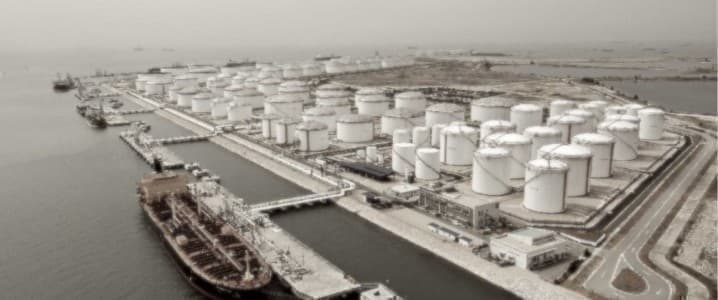The source of Iran’s relative independence in international affairs can be attributed to its oil and gas wealth. The country’s massive oil resources have contributed to a steady source of income which has fueled Tehran’s foreign policy. The election of President Trump in 2016 was the beginning of the biggest crisis in Iran since the war with neighboring Iraq in the 1980s. Chinese support is proving to be crucial as its buyers are stocking up on oil. The recent import volumes are so massive that certain Chinese ports are clogged up with ships carrying oil from Iran.
The Sino-Iranian oil connection
Ever since Deng Xiaoping’s market liberalization policies and, consequentially, massive economic expansion, China’s oil industry hasn’t been able to keep up with demand. Therefore, Middle Eastern imports are crucial for the Asian giant’s economy.
Iran's oil industry has been operating under sanctions for decades. The JCPOA, or the Iran Nuclear Deal, of 2015 provided sanctions relief in exchange for restrictions on the country's nuclear program. President Trump’s election, unilateral withdrawal from the agreement, and subsequent ‘maximum pressure’ policy significantly reduced Iran’s crude exports significantly and curbed production by approximately 2.5 mbpd.
Related Video: Why The Oil & Gas Rig Count Matters

Despite the restrictions, Iranian oil has found its way to international markets through the black market. Especially ship-to-ship transfers have obscured oil’s origin and provided moderate export capabilities. According to Kevin Wright, a Singapore-based analyst with Kpler, Chinese imports of Iranian crude will rise to 856,000 bpd in March which is a 129 percent rise from last month.
However, the vast majority of buyers are reluctant to import oil from Iran due to U.S. sanctions. Tehran, therefore, has used aggressive marketing to increase exports. Chinese buyers can receive a $3 to $5 discount compared to the Brent benchmark. Steadily rising global prices of oil, which briefly hit $71 for a barrel, have made Iranian crude popular in China.
The Sino-Iranian political axis
Since the revolution in 1979 Iran has followed a unique, Islamic, and revolutionary ideology that has set itself apart from its neighbors. Also, during the Cold War Tehran was staunchly independent from the leading powers of the time. The crises Iran is currently facing, however, are the most challenging since 1980s and the war with Iraq. Related: Are Analysts Underestimating Chinese Oil Demand?
The success of Iran’s foreign policy concerning the extended political influence in Iraq, Syria, Lebanon, and Yemen, has been perceived as threatening to its Sunni Arab neighbors. The unthinkable has even happened: a rapprochement between Sunni Arabs and Israel. Arguably, the Abraham Accords have been made possible by the perceived threat from Iran.
The combined economic, military and political pressure has reduced Tehran’s options. China is one of the few countries in the world with the resources and capabilities to alleviate some of the pressure. The New York Times leaked a preliminary $400 billion deal last year of a strategic agreement for the next 25 years. In it, Iran would receive an economic lifeline from China in exchange for preferential access to its massive oil and gas reserves. It would shake up the geopolitical balance of power in the region and threaten the United States’ position.
New President in the White House
The election of President Biden is a relief for the Iranian leadership. The President’s intention to revive the Nuclear Deal could be a sign of improving relations between the countries. Iranians, however, aren’t particularly eager to directly engage with the Americans. Especially, the current unilateral sanctions from the Trump era are a showstopper.
Tehran has made it clear that it won't enter into new negotiations until the sanctions are lifted. The scheduled presidential elections in Iran could be the cause for the country’s restraint. After 4 years of Trump, the positions have hardened. Moderates, including the current President Rohani, are careful as they could lose the elections to hardliners.
However, time is running out for the Americans. Every day that the economic crisis in Iran continues, the country slowly drifts into the Chinese sphere of influence. The growing energy relations between the countries is a clear sign of changing attitudes. President Biden has an incredibly difficult task: getting Tehran to sign a revised and updated Nuclear Agreement without strengthening Iran too much or driving it into the hands of its strategic rival.
By Vanand Meliksetian for Oilprice.com
More Top Reads From Oilprice.com:
- Oil Extends Losses On Renewed Demand Concerns
- Saudi Arabia Must Prepare For More Attacks On Its Oil Industry
- Oil Prices Retreat As Biden Plans Major Federal Tax Hike



















Moreover, Chinese imports of Iranian crude are underpinned by its strategic alliance with Iran and sweetened by a significant price discount ranging from $3-$5 a barrel. China has allocated a special place for Iran in its Belt and Road Initiative (BRI).
China’s future crude oil demand is insatiable. It is underpinned by a fast-growing economy projected to continue growing at an average 6.5% for the next few years and also double by 2035 from $24.20 trillion in 2020 based on purchasing power parity (PPP) to an estimated $48.4 trillion by 2035. To this could be added the impact of the BRI which is helping integrate the Chinese economy deeper into the global economy and giving it access to so many markets around the world.
Dr Mamdouh G Salameh
International Oil Economist
Visiting Professor of Energy Economics at ESCP Europe Business School, London